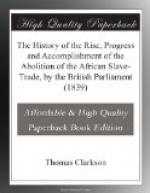To show this, I must first remind the reader, that Anthony Benezet, as soon as he heard of the result of the case of Somerset, opened a correspondence with Granville Sharp, which was kept up to the encouragement of both. In the year 1774, when he learned that William Dillwyn was going to England, he gave him letters to that gentleman. Thus one of the most conspicuous of the second class was introduced, accidentally as it were, to one of the most conspicuous of the first. In the year 1775, William Dillwyn went back to America, but, on his return to England to settle, he renewed his visits to Granville Sharp. Thus the connexion was continued. To these observations I may now add, that Samuel Hoare, of the same class as William Dillwyn, had, in consequence of the Bishop of Chester’s sermon, begun a correspondence in 1784, as before mentioned, with Mr. Ramsay, who was of the same class as Mr. Sharp. Thus four individuals of the two first classes were in the way of an union with one another.
But circumstances equally natural contributed to render an union between the members of the second and the third classes easily practicable also. For what was more natural than that William Dillwyn, who was born and who had resided long in America, should have connexions there? He had long cultivated a friendship (not then knowing to what it would lead) with James Pemberton. His intimacy with him was like that of a family connexion. They corresponded together; they corresponded also as kindred hearts, relative to the Slave Trade. Thus two members of the second and third classes had opened an intercourse on the subject and thus was William Dillwyn the great medium, through whom the members of the two classes now mentioned, as well as the members of all the three, might be easily united also, if a fit occasion should offer.
CHAPTER VII.
[Sidenote: Fourth class of forerunners and coadjutors up to 1787.—Dr. Peckard, vice-chancellor of the University of Cambridge, the first of these; gives out the Slave Trade as the subject for one of the annual prizes.—Author writes and obtains the first of these; reads his Dissertation in the Senate-house in the summer of 1785; his feelings on the subject during his return home; is desirous of aiding the cause of the Africans, but sees great difficulties; determines to publish his prize essay for this purpose; is accidentally thrown into the way of James Phillips, who introduces him to W. Dillwyn, the connecting medium of the three classes before mentioned; and to G. Sharp and Mr. Ramsay, and to R. Phillips.]
I proceed now to the fourth class of forerunners and coadjutors up to the year 1787 in the great cause of the abolition of the Slave Trade.




